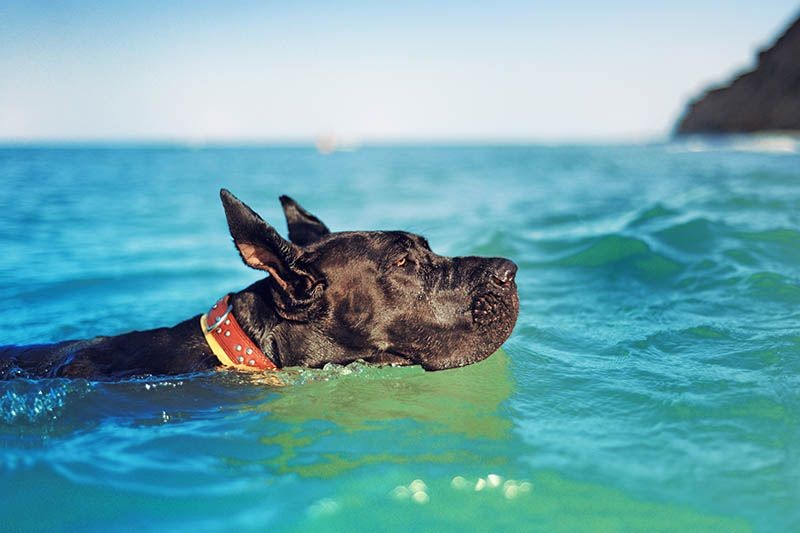
While Great Danes were not historically bred for water activities, these gentle giants can learn to swim effectively despite their large size. Originally developed as hunting dogs in 16th century Germany, Great Danes possess physical attributes that enable them to adapt to swimming - including long legs, muscular bodies, and extended necks. Though not natural water lovers, these dogs can become competent swimmers with proper training and exposure. The remarkable case of Millie, a competitive dock-diving Great Dane achieving jumps over 24 feet, demonstrates that these majestic canines can excel in water sports with appropriate guidance and safety measures.
Can Great Danes Swim?
Physical Swimming Capabilities
While Great Danes were not historically bred for swimming, their physical characteristics enable them to swim effectively. Their muscular build, long legs, and extended neck provide natural swimming advantages. The muscular upper body helps them stay afloat, while their long legs create an efficient paddle motion with increased surface-to-volume ratio. Their elongated neck and snout allow them to keep their heads above water easily while swimming. Some Great Danes even have webbed paws inherited from their hunting ancestors, providing better traction in water.
Competition and Achievement
While uncommon, some Great Danes excel at water sports at a competitive level. Millie, a notable Great Dane dock diver, demonstrates the breed's swimming potential by consistently achieving jumps averaging 23 feet, with a personal best of 24.5 feet. This places her in the "Elite" category for dock diving competitions, requiring jumps over 24 feet. Her success challenges typical breed expectations, though she represents an exception rather than the norm for Great Danes in water sports. Proper equipment like life vests and pool ramps are essential for Great Danes participating in water activities, particularly given their large size and unique body structure.
Can Great Danes Swim? Understanding Their Natural Swimming Abilities & Teaching Safe Swimming
Natural Swimming Instincts and Limitations
While the previous section covered physical capabilities, this section focuses specifically on Great Danes' natural swimming tendencies. As a breed, Great Danes generally do not have a natural affinity for water. Unlike breeds specifically bred for water activities, their hunting background did not involve aquatic tasks. However, like most dogs, they possess the instinctive ability to perform a "doggy paddle" when placed in water. Their swimming ability stems more from necessity than natural inclination, with many preferring to observe water activities from the shore rather than participate.
Progressive Training Approach
Early exposure and gradual introduction are key to developing swimming confidence in Great Danes. Start with shallow water environments like baby pools or bathtubs before progressing to deeper waters. The training should align with the individual dog's comfort level, as some may learn quickly while others require more time to build confidence. Supervision is crucial during swimming sessions, with particular attention to signs of fatigue or distress. Owners should maintain vigilance even with experienced swimmers, as Great Danes can tire quickly due to their size. Regular breaks and access to fresh drinking water are essential during swimming sessions to prevent exhaustion and dehydration.
Can Great Danes Swim: Safety Considerations & Water Adaptations
Water Safety Equipment & Precautions
While previous sections covered physical capabilities and training, this section focuses specifically on essential safety measures. Life vests designed for large breeds are crucial, particularly given Great Danes' deep chest cavity which can affect buoyancy. Portable ramps and steps provide secure entry and exit points, addressing the unique challenges posed by their size. These safety tools become especially important in deeper waters where exhaustion can set in more quickly for these giant breeds.
Environmental Adaptations
Understanding a Great Dane's response to different water environments is critical for their safety. Temperature sensitivity can significantly impact their swimming performance, with cold water potentially causing tooth chattering and refusal to enter. The water depth and clarity should be carefully assessed, as their size requires more space for comfortable movement. Indoor pools offer controlled environments for initial exposure, while natural water bodies demand additional precautions due to varying conditions. Owners should ensure swimming areas have gradual depth changes and clear visibility to help these large dogs maintain proper orientation and confidence in the water.
Conclusion
Great Danes possess the physical capability to swim effectively due to their muscular build, long legs, and extended neck structure, though they were not specifically bred for water activities. While some exceptional Great Danes like Millie have achieved success in competitive water sports, most members of the breed do not have a natural affinity for water and require careful training and safety considerations.
The research indicates that successful swimming for Great Danes depends on proper training, safety equipment, and environmental adaptations. A progressive training approach starting in shallow water, combined with essential safety gear like life vests and pool ramps, is crucial for these giant breeds. Given their size and potential for quick fatigue, owners must maintain vigilant supervision and provide appropriate swimming conditions, including comfortable water temperatures and adequate space for movement. These findings suggest that while Great Danes can swim, their participation in water activities should be carefully managed with proper preparation and safety measures in place.